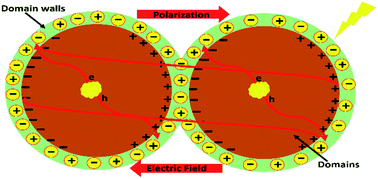Exploration of the intrinsic factors limiting the photocurrent density in ferroelectric BiFeO3 thin film†
Abstract
Ferroelectrics have ignited great interest in the field of photoelectrochemistry due to the built-in electric field assisted charge separation and switchable polarization. However, low photocurrent density limits their potential application. Herein, a photoelectrochemical study of optimized ferroelectric BiFeO3 film shows that positive and negative polarization by applying an external field may lead to enhancement of the p-type light response or reverse it to an n-type light response, and the BiFeO3 film may serve as either a photoanode or photocathode depending on the polarization conditions. Nevertheless, the low photocurrent density indicates that the unique switchable spontaneous polarization of ferroelectrics has not been fully exploited, which is due to severe charge recombination at the interfaces of the domain walls rather than recombination inside the domains. In order to take full advantage of charge separation by the spontaneous polarization field of ferroelectric materials, appropriate interface/domain wall engineering is necessary.



 Please wait while we load your content...
Please wait while we load your content...